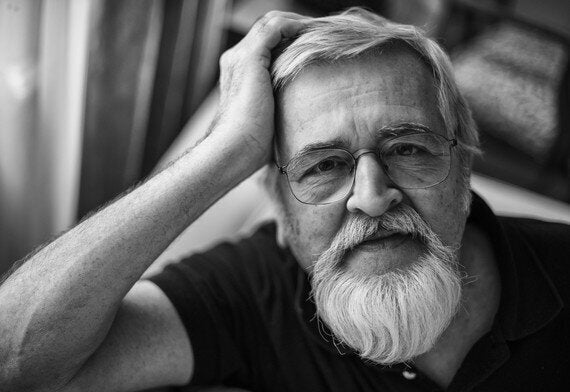If the treasures by which we better view ourselves are photographs, then it is to Bruce Fleming that we owe a debt of gratitude, for as one of the 1960s' master lensmen, he contributed to a collective body of photographic work which, in all likelihood, will never again be matched or bettered.

We live today in an era choked with impostors of no discernible worth or talent, yet Fleming, a mere fifty years ago, did not want for subjects to shoot. The 1960s, as a highpoint in western development, came in the wake of an age of extreme austerity.
"People were exhausted by the war," says Fleming in his Marylebone apartment, a man unbowed by the quicksand of time. "By the 1960s, there had to be an upswinging social movement because people were so fed up. It was as if someone had opened the door and let the sun in."
Fleming had spent the war as an evacuee and had painted as a child, but it wasn't until his mother bought him a Box Brownie that he began painting the prints he took, with the camera soon becoming his main instrument of art, his teenage years leading him to a stint in the RAF before attending Hornsey art school where he plugged straight into the zeitgeist with camera in hand, his senses attuned to the changing social milieu.
"Kids became affluent as the economy picked up, but they thought the old fogeys were running things in the UK, and they didn't like it. We felt we could make something better of the world."
And with photography his medium, into London he plunged, his big break in photojournalism coming in 1962 when, having doorstepped the offices of the Melody Maker for two weeks, he was sent by its editor to cover Eartha Kitt's show at the Talk of the Town. His shot of her lying on her coat on the stairs "like Marilyn Monroe" made the paper's front page and set him sure-footedly on his path.
Through his work at Ronnie Scott's, Fleming became friends with Zoot Sims, Stan Getz and Dexter Gordon. "We were all artists and we bloody well knew it," he says. "We all talked the same language. To this day I love to be around people who are creative, because it is so hard to be creative, to pluck things out of the air and write it, photograph it or paint it. The reward is in doing it. It makes your hair stand on end if you do it right."
Then in September 1966, Jimi Hendrix came into his orbit, a legend with whom Fleming became a fast friend. Fleming speaks of Jimi's other-worldliness, of a man who could stand next to you in a room while giving you the impression he was elsewhere. But for Fleming the creative high point of the decade was 1967, the year that gave the world the Monterey Pop Festival. He made the move to the US West Coast to catch the rising cultural wave. "I was in LA for most of that year and it was fantastic. There was a buzz there."

Having watched at close quarters Jimi's devotion to the guitar, he says that "if you want to do anything, do it with all your might. Creativity is a strange thing because you're getting close to god with it. If you do anything well for a long period of time, at a given point you're not doing it anymore...you are it. Photography for me is like breathing and walking."
Fleming's career has seen him cover Winston Churchill's funeral and the Apollo 17 launch for The Sunday Times, and while working for The People newspaper he was stabbed in the stomach by a drug dealer on Wardour Street when attempting to gain photographs for a feature on pill pushing. Wild times indeed.
He kept company with Terence Donovan, Brian Duffy and David Bailey who were named by Norman Parkinson as "the black trinity" because they supplanted the photographers of the day more at home at Cheyne Walk than Bethnal Green, the 1960s being the decade that reordered a British society clogged with the mould of faded post-war morality.
Yet a chagrin afflicts Fleming, the digitalisation of the photographic medium having had a deleterious effect upon his ability to create. "We were magicians once, but now anyone can create an image. So the standard of photography has gone through the floor. Digitalisation has destroyed the profession. There's a Turner Prize attitude to it now. It's no longer photography, it's image-making."
The rise of the great photographic libraries which claim ownership of images has also squeezed the profession into virtual non-existence having rendered the fine art/commercial photographer a person whose talent and services they can do without.
The profession, therefore, has imploded with economic expediency the culprit. "The big days have gone and I don't think they'll ever come back," agrees Fleming, "and I have a terrible feeling that, with digital images, we are in danger of deleting our own history, because no-one is holding on to film anymore and instead are relying upon digital files which are subject to corruption."
Indeed, today's cameras of super capability succeed in rendering the world in hues hyperreal and pin sharp, failing to capture a pictorial truth that was better claimed by the manual Hasselblads, Bronicas and Zeiss Ikon Contaflexes of yesteryear.
Today, photojournalism has been supplanted by a rampant hobbyism, itself the bastard child of the digital age where lurid images better suited to Manga comics make do in place of the artistry of Fleming and his redundant cohorts. Progress, after all, is progress. Only this will not do. Not at all.
Bruce will be exhibiting his work at the Zebra Gallery this spring
Portrait of Bruce at his home in Marylebone by Betina La Plante
Portrait of Jimi Hendrix, Mitch Mitchell & Noel Redding by Bruce Fleming
